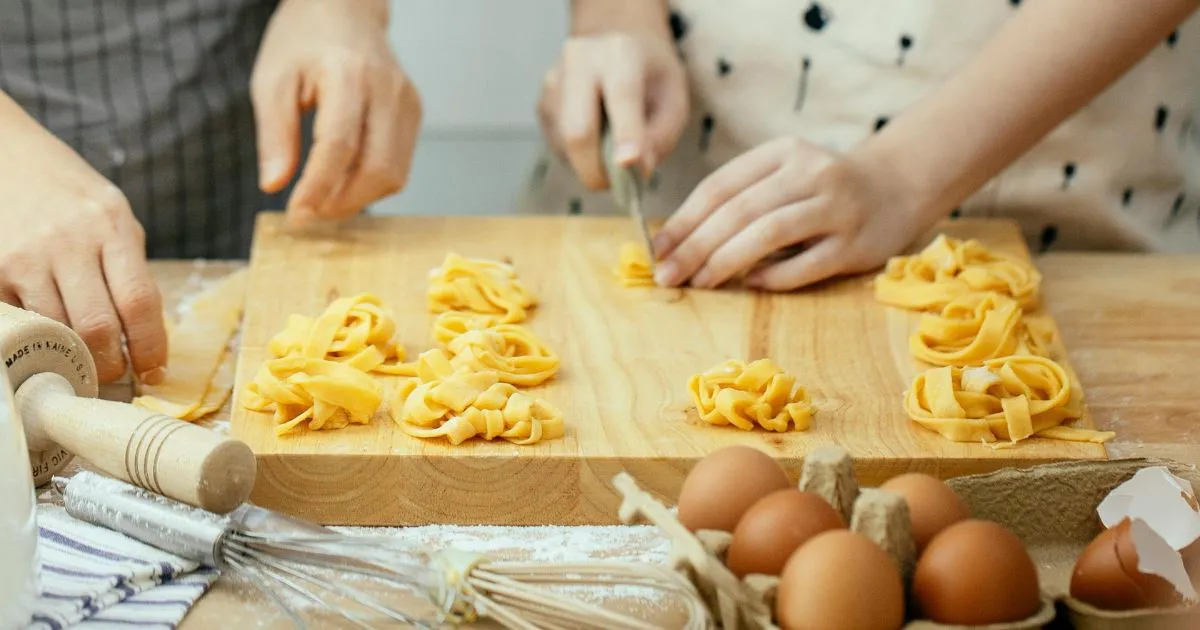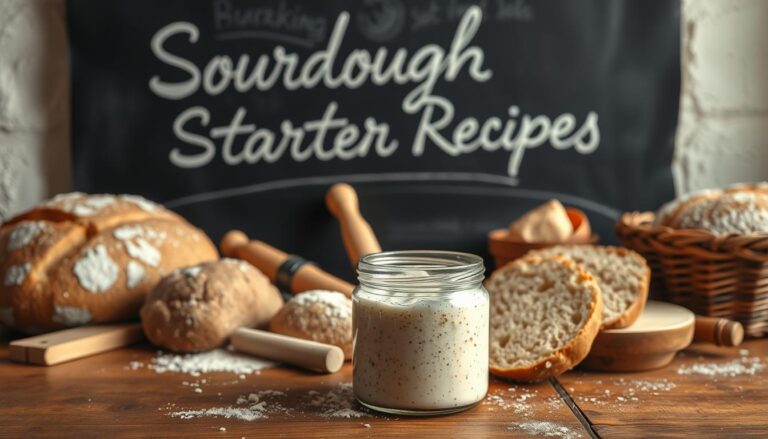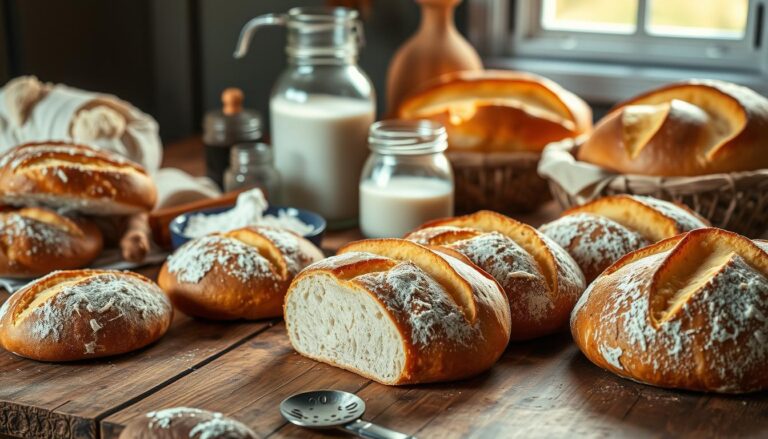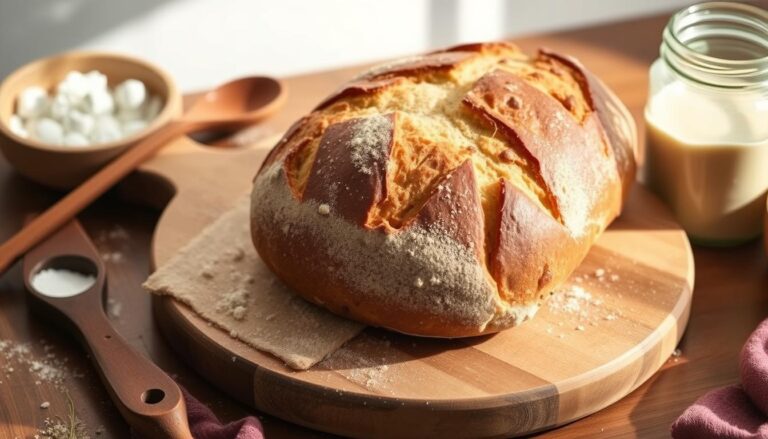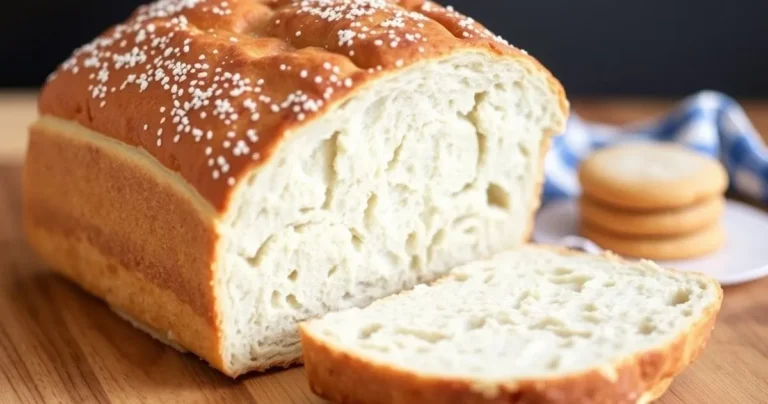Best Cinnamon Rolls with Sourdough Discard – No Waste, All Yum!
Baking with sourdough discard is a great way to reduce waste and create delicious treats. One popular question among bakers is whether it’s possible to make cinnamon rolls using sourdough discard. The answer is yes, and it’s a fantastic way to give this classic pastry a tangy twist.
Using sourdough discard in cinnamon rolls not only reduces waste but also adds a unique flavor profile. The natural yeast in the discard helps in fermentation, giving the rolls a lighter texture and a more complex taste.
In this article, we’ll explore the process of making sourdough cinnamon rolls, including tips on how to incorporate sourdough discard into your recipe effectively.
Table of Contents
The Magic of Sourdough Discard in Baking
Transforming sourdough discard into cinnamon rolls is a game-changer for bakers. Sourdough discard, a byproduct of maintaining a sourdough starter, is often overlooked but holds immense potential in baking. By utilizing discard, bakers can create delicious treats while reducing waste.
What Is Sourdough Discard?
Sourdough discard refers to the portion of the sourdough starter that is removed and discarded during the feeding process to maintain the starter’s health and balance. This discard is still teeming with wild yeast and bacteria, making it perfect for various baking applications.
The discard has a unique characteristic – it’s tangy and slightly sour, which can add depth to baked goods. Many bakers wonder if they can use this discard in recipes, and the answer is a resounding yes.
Benefits of Using Discard Instead of Throwing It Away
Using sourdough discard in baking has several benefits. Firstly, it reduces waste, making the baking process more sustainable. Secondly, it adds a unique flavor profile to baked goods, enhancing their overall taste.
| Benefits | Description |
|---|---|
| Reduces Waste | Utilizing discard minimizes the waste generated during sourdough starter maintenance. |
| Unique Flavor | The tangy flavor of the discard adds a unique twist to baked goods, making them more flavorful. |
| Sustainability | By using discard, bakers contribute to a more sustainable baking practice. |
By incorporating sourdough discard into recipes like cinnamon rolls, bakers can create products that are not only delicious but also environmentally friendly.
Why Discard Cinnamon Rolls Are Worth Making
The use of sourdough discard in cinnamon rolls not only reduces food waste but also elevates the taste and nutritional value. This approach to baking is both sustainable and rewarding, offering bakers a chance to create something delicious while minimizing their environmental footprint.
Unique Flavor Profile
Sourdough discard cinnamon rolls boast a complex flavor profile that is both tangy and sweet. The sourdough discard adds a depth of flavor that is hard to achieve with traditional yeast. This unique taste is due to the lactic acid produced during the sourdough fermentation process, which contributes to a more nuanced and interesting flavor experience.
The combination of the sourdough’s tanginess with the sweetness of the cinnamon and sugar creates a delicious contrast that elevates the traditional cinnamon roll to a new level. Here are some key aspects of this unique flavor profile:
- Tangy flavor from the sourdough discard
- Sweetness from the cinnamon sugar
- Complex, nuanced taste experience
Texture and Health Advantages
Besides the unique flavor, sourdough discard cinnamon rolls also offer several texture and health advantages. The sourdough discard contributes to a softer, more tender crumb due to the acids present, which help to break down some of the gluten, making the rolls easier to digest.
Some of the health benefits include:
- Lower glycemic index due to the presence of lactic acid, which slows down sugar digestion
- Easier digestibility because of the partial breakdown of gluten
- Nutritional benefits from the sourdough starter, including increased bioavailability of minerals
By choosing to make sourdough discard cinnamon rolls, bakers can enjoy a delicious treat that is not only flavorful but also has potential health benefits, making it a worthwhile baking endeavor.
Essential Ingredients for Perfect Sourdough Cinnamon Rolls
The foundation of exceptional sourdough cinnamon rolls lies in the quality and combination of their ingredients. To create these delightful pastries, it’s crucial to understand the role of each component, from the dough to the filling and the final glaze.
Dough Components
The dough is the backbone of sourdough cinnamon rolls, and its quality depends on several key ingredients.
- Flour: The type of flour used can significantly affect the texture and flavor. A high-protein flour, such as bread flour, is recommended for its ability to create a strong gluten structure.
- Sourdough Discard: This is a key ingredient that not only reduces waste but also adds a unique tanginess and depth to the rolls.
- Sugar: A small amount of sugar is necessary to balance the flavors and aid in the yeast fermentation process.
- Eggs: Eggs enrich the dough, contributing to a tender crumb and richer flavor.
- Butter or Oil: The choice between butter and oil can affect the flavor and tenderness. Butter adds a richer flavor, while oil can result in a tender, moist crumb.
| Ingredient | Function | Recommended Type |
|---|---|---|
| Flour | Structure and Texture | Bread Flour |
| Sourdough Discard | Flavor and Fermentation | Active Sourdough Discard |
| Sugar | Flavor and Yeast Fermentation | Granulated Sugar |
Creating the Perfect Cinnamon Filling
The cinnamon filling is a crucial element that gives sourdough cinnamon rolls their characteristic flavor and aroma.
Cinnamon: High-quality cinnamon is essential for the best flavor. Consider using Ceylon or Cassia cinnamon for their distinct, warm flavors.
- Sugar: Brown sugar is often used in the filling for its rich, caramel-like flavor when baked.
- Butter: Softened butter is mixed with the sugar and cinnamon to create a smooth, spreadable paste.
Frosting and Glaze Options
The final touch for sourdough cinnamon rolls is the frosting or glaze, which adds an extra layer of flavor and visual appeal.
A simple powdered sugar glaze, made with powdered sugar and milk or cream, is a classic choice. For a richer frosting, consider a cream cheese frosting, which pairs well with the tanginess of the sourdough.
Equipment and Tools You’ll Need
The right equipment can make a significant difference in the outcome of your sourdough cinnamon rolls. To ensure a smooth baking process, it’s crucial to have the necessary tools on hand.
Essential Baking Tools
To start, you’ll need some basic baking tools. These include a large mixing bowl for combining ingredients, a dough scraper for handling the dough, and a lightly floured surface for kneading. A digital scale is also essential for accurately measuring ingredients, which is critical in baking. Additionally, you’ll need a rolling pin to roll out the dough to the right thickness and a sharp knife or pastry cutter to cut the rolls. A muffin tin or baking dish is necessary for proofing and baking the rolls.
Other essential tools include parchment paper for lining the baking dish and a cooling rack for cooling the rolls after baking.
Optional but Helpful Items
While not necessary, some tools can make the process easier and more efficient. A stand mixer with a dough hook attachment can significantly reduce the effort required for mixing and kneading the dough. A banneton or proofing basket can help create a more evenly proofed dough, and a pastry brush is handy for applying egg wash or melted butter to the rolls. A dough laminating tool can also be useful for achieving the perfect layers in your cinnamon rolls.
Complete Sourdough Discard Cinnamon Rolls Recipe
To make sourdough discard cinnamon rolls, you’ll need to follow a simple yet rewarding recipe that yields delicious results. This recipe guides you through preparing your sourdough discard, mixing and developing the dough, the rising processes, and finally, baking the rolls to perfection.
Preparing Your Discard
Before you start, ensure your sourdough discard is at room temperature and has a tangy aroma, indicating it’s active and ready to use. If your discard is cold, let it sit at room temperature for a few hours to activate it. You will need about 1 cup (240g) of sourdough discard for this recipe.
Tip: Always refresh your sourdough discard before using it in recipes to ensure it’s active and has the right consistency.
Mixing and Developing the Dough
In a large mixing bowl, combine 1 cup (240g) of sourdough discard, 1/2 cup (120ml) of warm milk, 1/4 cup (60g) of granulated sugar, and 2 large eggs. Mix these ingredients until they’re well combined. Then, add 3 cups (375g) of all-purpose flour, 1 teaspoon of salt, and 1 tablespoon of unsalted butter, melted, to the mixture. Mix until a shaggy dough forms.
Using a stand mixer with a dough hook attachment, knead the dough for about 5-7 minutes until it becomes smooth and elastic. If kneading by hand, expect to spend around 10 minutes to achieve the same result.
| Ingredient | Quantity | Unit |
|---|---|---|
| Sourdough Discard | 1 | cup (240g) |
| Warm Milk | 1/2 | cup (120ml) |
| Granulated Sugar | 1/4 | cup (60g) |
| Large Eggs | 2 | |
| All-Purpose Flour | 3 | cups (375g) |
| Salt | 1 | teaspoon |
| Unsalted Butter | 1 | tablespoon |
First Rise Process
Place the dough in a greased bowl, cover it with a damp cloth, and let it rise in a warm, draft-free place. The dough should double in size within about 4-6 hours, depending on the temperature and the activity of your sourdough discard.
Rolling, Filling, and Shaping Techniques
Once the dough has risen, punch it down and roll it out into a large rectangle, about 1/4-inch thick. Spread a mixture of softened butter, cinnamon, and sugar evenly over the dough, leaving a small border around the edges.
Roll the dough into a tight log, starting from the long side. Cut the log into 12-15 equal pieces and place them in a greased baking dish, leaving some space between each roll for expansion.
Second Rise and Baking Instructions
Cover the rolls with a damp cloth and let them rise again for about 2-3 hours, or until they’ve doubled in size. Preheat your oven to 375°F (190°C). Bake the rolls for 18-22 minutes, or until they’re golden brown.
Tip: Keep an eye on your rolls during the baking time, as oven temperatures can vary.
Timing and Planning Your Bake
To make the most of your sourdough discard, timing is everything when it comes to baking cinnamon rolls. Effective planning ensures that your rolls turn out perfectly, whether you’re baking on the same day or preparing ahead for a special occasion.
Baking sourdough cinnamon rolls is a multi-step process that requires some planning. The key to achieving the perfect treat lies in understanding the timing involved in the recipe. This includes preparing the dough, letting it rise, and baking the rolls to perfection.
Same-Day Baking Schedule
For those who want to bake their sourdough cinnamon rolls on the same day, here’s a general outline to follow:
- Morning: Mix the dough and let it rest for the autolyse phase.
- Late Morning: Add sourdough discard and other ingredients to the dough, then mix and knead.
- Early Afternoon: Let the dough rise until it has doubled in size.
- Late Afternoon: Roll out the dough, spread the cinnamon filling, and shape the rolls.
- Early Evening: Let the shaped rolls rise again before baking.
- Evening: Bake the rolls and enjoy them fresh.
This schedule assumes a total time of around 8-10 hours, depending on factors like room temperature and the strength of your sourdough discard.
Planning for Special Occasions
When planning to bake sourdough cinnamon rolls for special occasions or events, it’s essential to consider the timing carefully. You can prepare the dough ahead of time and store it in the refrigerator overnight, allowing you to bake fresh rolls in the morning.
This flexibility makes sourdough cinnamon rolls an excellent choice for breakfast gatherings or holiday treats. By planning ahead, you can ensure that your rolls are freshly baked and perfect for your event.
Overnight Sourdough Cinnamon Rolls Method
The overnight method for sourdough cinnamon rolls is a game-changer for bakers who want to enjoy freshly baked goods in the morning. This approach allows for a more relaxed baking schedule, making it ideal for special occasions or busy mornings.
By leveraging the natural fermentation process of sourdough, bakers can create a more complex flavor profile and tender texture in their cinnamon rolls. The key to successful overnight sourdough cinnamon rolls lies in adjusting the recipe to accommodate the longer fermentation time.
Recipe Adjustments for Overnight Fermentation
To make sourdough cinnamon rolls using the overnight method, you’ll need to adjust the recipe to ensure the dough ferments properly. Reducing the yeast (if using) and adjusting the temperature can help control the fermentation process.
- Use a preferment or autolyse to enhance dough development.
- Keep the dough at a cooler temperature to slow down fermentation.
- Monitor the dough’s progress to determine the optimal proofing time.
According to expert bakers, “The beauty of sourdough lies in its flexibility and the ability to adapt recipes to suit different schedules and preferences.” By making a few simple adjustments, you can enjoy freshly baked sourdough cinnamon rolls in the morning.
Morning Baking Process
In the morning, the process of baking your sourdough cinnamon rolls is straightforward. Shape the dough, let it rise, and bake to perfection. The result is a deliciously aromatic and flavorful treat.
- Shape the fermented dough into rolls and place them in a baking dish.
- Let the rolls rise for a shorter period, typically 1-2 hours, depending on the temperature and dough condition.
- Bake the rolls in a preheated oven until golden brown.
The end result of using the overnight sourdough cinnamon rolls method is a batch of freshly baked, delicious cinnamon rolls with a tender texture and rich flavor. This method is perfect for bakers looking to simplify their baking routine without sacrificing quality.
Troubleshooting Common Sourdough Roll Problems
Bakers often encounter issues when making sourdough cinnamon rolls, but these can be easily resolved with the right troubleshooting techniques. Understanding the common problems that arise during the baking process can help you achieve perfect results every time.
Dough Consistency Issues
The consistency of your sourdough dough is crucial for the final texture of your cinnamon rolls. If your dough is too dry, it may be due to overmixing or using too much flour. On the other hand, if it’s too wet, it could be a result of overproofing or insufficient flour.
- To fix dry dough, try adding a small amount of water.
- For wet dough, gently add more flour until you achieve the right consistency.
Rising and Proofing Challenges
Rising and proofing are critical steps in making sourdough cinnamon rolls. Issues during these stages can lead to dense or flat rolls.
| Issue | Cause | Solution |
|---|---|---|
| Poor rise | Insufficient proofing time, incorrect temperature | Ensure adequate proofing time and maintain a consistent temperature between 75°F to 80°F. |
| Overproofing | Dough left to proof for too long | Monitor the dough closely and bake when it’s appropriately proofed. |
Filling and Rolling Problems
The process of filling and rolling your sourdough cinnamon rolls can sometimes be tricky. If the dough tears during rolling, it may be too cold or too dry.
To avoid this, ensure your dough is at room temperature and has the right consistency before attempting to roll it out.
Baking and Texture Concerns
The final baking stage is where your sourdough cinnamon rolls come together. Issues such as underbaking or overbaking can significantly affect the texture.
To achieve the perfect bake, ensure your oven is at the correct temperature and bake until the rolls are golden brown.
Creative Variations for Your Discard Cinnamon Rolls
Discover the versatility of sourdough discard cinnamon rolls through exciting flavor and texture variations. Whether you’re looking to match the season, accommodate dietary restrictions, or simply add a personal touch, there are countless ways to innovate this classic recipe.
Seasonal Flavor Adaptations
One of the joys of baking with sourdough discard is the ability to adapt recipes to the season. For example, you can infuse your cinnamon rolls with:
- Lemon zest and poppy seeds in the spring
- Warm spices like nutmeg and cardamom in the fall
- Cranberries and orange zest during the winter holidays
These seasonal flavors not only keep your baking fresh and exciting but also make your creations perfect for various celebrations throughout the year.
Dietary Modifications
Making your sourdough discard cinnamon rolls inclusive for all diets is easier than you think. For vegan options, replace eggs with flaxseed or applesauce and use plant-based milk. For gluten-free variations, experiment with almond flour or gluten-free all-purpose flour blends, adjusting liquid content as needed.
| Dietary Need | Modification |
|---|---|
| Vegan | Replace eggs with flaxseed or applesauce; use plant-based milk |
| Gluten-Free | Use almond flour or gluten-free flour blends; adjust liquid content |
Mix-ins and Toppings
The possibilities for mix-ins and toppings are endless, allowing you to personalize your cinnamon rolls to your taste. Consider adding chopped nuts, dried fruits, or even chocolate chips to the dough for added texture and flavor. For toppings, a simple glaze made from powdered sugar and milk can be a delightful finish, or try a cream cheese frosting for a tangy contrast.
Storage, Freezing and Reheating Tips
The key to maintaining the freshness of your sourdough cinnamon rolls lies in proper storage and reheating techniques. After you’ve baked your rolls to perfection, it’s crucial to store them in a way that preserves their texture and flavor.
Keeping Your Rolls Fresh
To keep your sourdough cinnamon rolls fresh, store them in an airtight container at room temperature for up to 2 days. You can also wrap them individually in plastic wrap or aluminum foil to maintain freshness. If you live in a humid climate, consider storing them in the refrigerator to prevent mold growth.
Tips for Short-Term Storage:
- Cool the rolls completely before storing
- Use an airtight container or wrap individually
- Store at room temperature or in the refrigerator
Freezing and Thawing Methods
For longer storage, freezing is an excellent option. To freeze your sourdough cinnamon rolls, place them on a baking sheet lined with parchment paper and put it in the freezer until they are frozen solid. Then, transfer the frozen rolls to a freezer-safe bag or container.
| Storage Method | Duration | Notes |
|---|---|---|
| Room Temperature | Up to 2 days | Airtight container |
| Refrigerator | Up to 5 days | Prevents mold growth in humid climates |
| Freezer | Up to 2 months | Freeze individually before storing in a bag/container |
To thaw, simply leave the rolls at room temperature or reheat them in the microwave/oven. With these storage and reheating tips, you can enjoy your sourdough cinnamon rolls for days to come.
Conclusion
Creating cinnamon rolls with sourdough discard is a rewarding experience that combines the tanginess of sourdough with the sweetness of cinnamon. By following the steps outlined in this article, you can produce delicious discard cinnamon rolls that are sure to impress.
The sourdough cinnamon rolls recipe provided offers a unique flavor profile and texture that is both tender and flavorful. With the right ingredients, equipment, and techniques, you can achieve professional-quality results in the comfort of your own kitchen.
Whether you’re a seasoned baker or just starting out, experimenting with sourdough discard recipes like these cinnamon rolls can be a fun and creative way to reduce waste and produce delicious treats. So why not give it a try and discover the joy of baking with sourdough discard?
FAQ
Can I use sourdough discard straight from the fridge for making cinnamon rolls?
Yes, you can use sourdough discard straight from the fridge, but it’s best to let it come to room temperature before using it in your recipe to ensure it’s active and will help your dough rise properly.
How long can I store sourdough discard cinnamon rolls in the fridge?
Sourdough discard cinnamon rolls can be stored in an airtight container in the fridge for up to 3-4 days. Simply reheat them when you’re ready to serve.
Can I freeze the dough for sourdough cinnamon rolls?
Yes, you can freeze the dough after the first rise. Simply thaw it in the fridge or at room temperature when you’re ready to proceed with rolling and baking.
What’s the best way to reheat sourdough cinnamon rolls?
To reheat sourdough cinnamon rolls, wrap them in foil and warm them in the oven at 350°F (175°C) for about 10-15 minutes, or until they’re soft and fragrant.
Can I make sourdough cinnamon rolls without a stand mixer?
Absolutely, you can make sourdough cinnamon rolls without a stand mixer. Simply mix the ingredients together by hand or with a hand mixer, and then knead the dough for about 10 minutes until it becomes smooth and elastic.
How do I know if my sourdough discard is still good to use?
Check your sourdough discard for any visible signs of mold or an off smell. If it passes these checks, it’s likely still good to use. You can also perform a simple float test by dropping a small amount of the discard into a cup of water; if it floats, it’s ready to use.
Can I make overnight sourdough cinnamon rolls?
Yes, you can make overnight sourdough cinnamon rolls by adjusting the recipe to allow for a longer fermentation time. This can be a convenient option for baking in the morning.
Are sourdough cinnamon rolls healthier than traditional cinnamon rolls?
Sourdough cinnamon rolls can be considered a healthier option due to the presence of lactic acid, which can make the sugars and flour more easily digestible. However, they still contain sugar and calories, so moderation is key.

